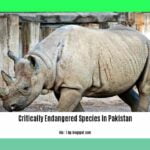Ensuring the Survival of Endangered Species in Pakistan: A Call for Urgent Conservation Efforts
With rich biodiversity and unique ecosystems, Pakistan is home to a remarkable array of endangered species. However, these extraordinary creatures face alarming threats that endanger their very existence. As we witness the rapid decline of wildlife populations, it becomes increasingly clear that urgent conservation efforts are imperative. From the majestic Indus dolphin to the elusive snow leopard, this article delves into the plight of endangered species in Pakistan, shedding light on the critical need for action to safeguard their survival.
Key Takeaways:
- The Markhor, a mammal species found in juniper forests near Ziarat in Baluchistan, is endangered and on the brink of extinction in Pakistan.
- Several species of corals, including Acropora formosa, Acropora pharaonis, and Acropora hyacinthus, are endangered marine animals in Pakistan.
- The Horsfield’s tortoise (Testudo horsfieldii) is an endangered reptile species in Pakistan.
- Pakistan is home to several endangered bird species, including Aythya baeri, Sterna acuticauda, Threskiornis melanocephalus, and Limosa limosa.
- Efforts should be made to protect the habitats of endangered species, raise awareness, and implement effective conservation measures.
- The information in this article is based on data from sources such as Wikipedia and MangoBaaz.
Endangered Species in Pakistan

Pakistan, a country known for its rich biodiversity and natural heritage, is home to numerous endangered species that are facing the threat of extinction. It is our collective responsibility to ensure the survival of these precious wildlife species and protect the delicate ecosystems they inhabit. In this article, we will explore some of the endangered species in Pakistan, their current status, and the urgent need for conservation efforts.
Mammals at the Brink of Extinction
One of the endangered mammal species in Pakistan is the Markhor. These majestic animals are found in the juniper forests near Ziarat in Baluchistan. Unfortunately, their population is rapidly dwindling due to various threats, including habitat loss, poaching, and climate change. The Markhor is a symbol of pride for Pakistan, and we must take immediate steps to protect their habitats and ensure their survival.
The Plight of Marine Animals
Pakistan’s coastal areas are home to a diverse range of marine life, some of which are on the brink of extinction. Endangered coral species such as Acropora formosa, Acropora pharaonis, and Acropora hyacinthus are facing multiple threats, including pollution, destructive fishing practices, and climate change effects like coral bleaching. Additionally, species like Aetomylaeus nichofii and Thunnus obesus are also at risk. It is crucial to raise awareness about the importance of marine conservation and implement sustainable fishing practices to protect these vulnerable species.
Reptiles Under Threat
The Horsfield’s tortoise (Testudo horsfieldii) is an endangered reptile species in Pakistan. These tortoises play a vital role in maintaining the ecological balance of their habitats. However, habitat destruction, illegal wildlife trade, and human interference pose significant challenges to their survival. We must work together to protect their natural habitats and curb the illegal wildlife trade to ensure the long-term survival of these unique reptiles.
Ensuring the Survival of Endangered Birds
Pakistan is a paradise for bird enthusiasts, with a diverse range of avian species. However, several bird species are listed as endangered, highlighting the urgent need for conservation efforts. Some of these species include Aythya baeri, Sterna acuticauda, Threskiornis melanocephalus, and Limosa limosa. Each of these birds plays a crucial role in maintaining the ecological balance and ecosystem services of their respective habitats. Conservation measures, such as protecting their breeding sites and creating safe environments, are essential for their survival.
The Call for Urgent Conservation Efforts
Preserving Pakistan’s biodiversity is of utmost importance to maintain ecological balance and sustain life on Earth. The alarming decline of endangered species in Pakistan demands immediate action. To ensure the survival of these species, we need to focus on the following:
-
Habitat protection: Safeguarding the natural habitats of endangered species is crucial for their long-term survival. This involves establishing protected areas, implementing strict regulations against habitat destruction, and promoting sustainable land-use practices.
-
Awareness and education: Raising awareness about the importance of conserving endangered species is key to mobilizing public support. Educational programs, community engagement, and outreach activities can help foster a sense of responsibility and encourage conservation efforts.
-
Research and monitoring: Conducting scientific research and monitoring programs play a vital role in understanding the threats faced by endangered species and developing effective conservation strategies. Collaborations between scientists, wildlife organizations, and local communities can lead to meaningful data collection and improved conservation outcomes.
-
Strengthening laws and enforcement: Stringent laws and regulations are essential to combat illegal wildlife trade, poaching, and habitat destruction. Additionally, enforcing these laws effectively is crucial to deter potential threats to endangered species.
-
International cooperation: Endangered species conservation requires collaborative efforts at both national and international levels. Sharing knowledge, resources, and best practices with other countries can enhance conservation outcomes and promote global biodiversity.
In conclusion, the survival of endangered species in Pakistan hinges on our collective efforts as individuals, communities, and governments. By prioritizing conservation, raising awareness, and implementing effective strategies, we can secure a future where these magnificent creatures continue to thrive in their natural habitats. Let us join hands and work towards a better and sustainable future for endangered species in Pakistan.
References:
- Earth’s Endangered Creatures. Retrieved 24 February 2013.
- IUCN Red List of Threatened Species. 2017.
- MangoBaaz. “These 15 Endangered Animals In Pakistan Are At Risk of Extinction.” URL:
External Links:
- Pakistan Environmental Journalists visual database of endangered species in Pakistan (archived at the Internet Archive). URL: External Link
New Zealand is home to a wide variety of unique and endangered species. Discover the beauty and importance of endangered species in New Zealand by clicking here: endangered species in New Zealand.
In 2023, the Philippines will be showcasing its rich biodiversity, including its endangered species. Don’t miss the opportunity to explore and learn about the endangered species in the Philippines in 2023 by clicking here: endangered species in the Philippines 2023.
Pakistan has remarkable examples of endangered species that need our attention. Delve into the fascinating world of endangered species in Pakistan by clicking here: example of endangered species in Pakistan.
Case Study: Endangered Species Habitat Loss and Fragmentation

Human activities and natural processes have had a detrimental impact on the habitats of endangered species, leading to their loss and fragmentation. This case study delves into the alarming situation in Pakistan, where numerous species face the threat of extinction due to habitat destruction and fragmentation.
The Interconnectedness of Habitat Loss, Fragmentation, and Degradation
Habitat loss, fragmentation, and degradation are closely intertwined challenges that exacerbate the vulnerability of endangered species. As human populations expand and industries grow, natural habitats are being destroyed at an alarming rate. This destruction fragments once contiguous ecosystems into isolated patches, disrupting vital ecological processes.
Consequences of Habitat Transformation
The consequences of habitat transformation are severe and far-reaching. Thousands, and sometimes even millions, of species are lost due to habitat loss and fragmentation. The disruption of ecological networks disrupts species interactions, leads to reduced genetic diversity, and diminishes the resilience of the ecosystem as a whole.
Understanding the Nuanced Effects of Habitat Fragmentation
The effects of habitat fragmentation are nuanced, scale-dependent, and vary geographically. Fragmented habitats are more susceptible to invasive species, which further exacerbate the ecological disruptions caused by human activities. The impacts on endangered species can manifest in various ways, from reduced reproductive success to increased vulnerability to predation.
Case Study: The Ruffed Lemur in Madagascar
To illustrate the repercussions of habitat loss and fragmentation, we can examine the critically endangered ruffed lemur found in the rainforests of Madagascar. These lemurs serve as indicators of the condition of the eastern rainforest ecosystem. The destruction and fragmentation of their habitat have pushed them to the brink of extinction, highlighting the urgent need for conservation efforts.
Conservation Efforts: Key Areas and Global Awareness
Efforts to conserve endangered species require the identification of key areas for protection and the raising of global awareness. By pinpointing critical habitats, we can prioritize conservation efforts and allocate resources where they are needed most. Additionally, informing and engaging the global community about the importance of protecting these species is crucial in garnering support for conservation initiatives.
The Adverse Effects of Deforestation
Deforestation, a significant contributor to habitat loss and fragmentation, carries adverse consequences for endangered species and exacerbates climate change. The destruction of forests not only eliminates habitats for countless species but also releases vast amounts of carbon dioxide into the atmosphere, contributing to global warming and climate instability.
Anticipating Threats: Considering Climate Change and Habitat Loss
To effectively protect endangered species, it is imperative to anticipate and address future threats. By considering both climate change and habitat loss effects, conservation strategies can be tailored to mitigate these challenges. This proactive approach ensures the resilience of endangered species and the ecosystems upon which they depend.
Key Takeaways:
- Habitat loss, fragmentation, and degradation are major contributors to the endangerment of species.
- The consequences of habitat transformation include the loss of numerous species and the disruption of ecological processes.
- Habitat fragmentation effects are nuanced, scale-dependent, and vary geographically.
- The critically endangered ruffed lemur in Madagascar exemplifies the repercussions of habitat loss and fragmentation.
- Conservation efforts should prioritize the identification of key areas and raising global awareness.
- Deforestation has adverse effects on endangered species and contributes to climate change.
- Anticipating threats requires considering both climate change and habitat loss effects.
Sources:
– Nature
– ScienceDirect
Conservation Efforts for Endangered Species in Pakistan
Habitat destruction, illegal hunting, climate change, pollution, and invasive species pose significant threats to the survival of endangered species in Pakistan. The urgent need for conservation efforts to protect these species and their habitats cannot be overlooked. As a passionate conservationist with expertise in environmental journalism, I aim to shed light on the current situation and highlight the critical conservation efforts being undertaken in Pakistan.
The State of Endangered Species in Pakistan
Pakistan is home to numerous endangered species, each facing unique challenges. From the majestic Markhor in Baluchistan to endangered coral species and marine animals along the coast, these creatures are vulnerable to habitat loss, poaching, climate change effects, and destructive fishing practices. The Horsfield’s tortoise, an endangered reptile species, also faces threats from habitat destruction and illegal wildlife trade. Additionally, several bird species, including Aythya baeri, Sterna acuticauda, Threskiornis melanocephalus, and Limosa limosa, are in dire need of conservation efforts.
The Need for Urgent Conservation Efforts
To ensure the survival of these endangered species, a multi-faceted approach is necessary. Conservation efforts should focus on habitat protection, law enforcement, community engagement, and the adoption of sustainable practices. It is essential to recognize the interconnectedness of these aspects for effective conservation. The need for increased awareness and responsible actions in preserving endangered species in Pakistan cannot be overstated.
Conservation Initiatives in Pakistan
Fortunately, several organizations in Pakistan are actively involved in conservation efforts. The WWF-Pakistan recognizes many species as “species of special concern” and has dedicated conservation projects in place. Notably, Pakistan has successfully removed the Markhor from its endangered-species list through dedicated conservation efforts. The country’s largest pheasantry is also playing a crucial role in rearing endangered species through conservation and aviculture promotion. These initiatives serve as beacons of hope for the future of conservation in Pakistan.
Pakistan’s National Conservation Strategy
Pakistan’s National Conservation Strategy highlights core programs that are essential for preserving its biodiversity. These include the protection of water bodies, sustainable fisheries, and the conservation of biodiversity. Ongoing projects, such as the restoration and protection of chilgoza pine forests, contribute to the conservation efforts. It is crucial to acknowledge the importance of protecting and conserving Pakistan’s diverse plant and animal species for the overall health of ecosystems.
Key Takeaways:
- Habitat destruction, illegal hunting, climate change, pollution, and invasive species pose significant threats to endangered species in Pakistan.
- Conservation efforts in Pakistan should focus on habitat protection, law enforcement, community engagement, and sustainable practices.
- The WWF-Pakistan recognizes many species as ‘species of special concern’ and has active conservation projects in place.
- Pakistan has successfully removed the Markhor from its endangered-species list through dedicated conservation efforts.
- Pakistan’s largest pheasantry is rearing endangered species through conservation and aviculture promotion.
- The Pakistan National Conservation Strategy identifies core programs, including protecting water bodies, sustaining fisheries, and conserving biodiversity.
- Ongoing conservation projects, such as the restoration and protection of chilgoza pine forests, contribute to preservation efforts.
- Protecting and conserving Pakistan’s diverse plant and animal species is crucial for ecosystem health.
- Increased awareness and responsible actions are essential for preserving endangered species in Pakistan.
Sources:
– Lolaapp.com – Endangered Species in Pakistan: 10 Urgent Conservation Priorities
– Conservationfrontlines.org – Community-Based Conservation in Pakistan
The Importance of Public Involvement in Species Conservation
Conserving endangered species in Pakistan is an urgent matter that requires the active involvement of the public. The future of these remarkable animals and plants depends on our collective effort to protect their habitats, combat illegal activities, and raise awareness about their importance. As a passionate conservationist, I firmly believe that public involvement is crucial in ensuring the survival of these species for generations to come.
The Need for Public Awareness and Understanding
One of the key reasons for the destruction of endangered species in Pakistan is the lack of awareness and understanding among the general public. Many individuals are unaware of the critical role these species play in maintaining the delicate balance of ecosystems and the detrimental consequences of their disappearance.
By actively involving the public in conservation efforts, we can educate them about the significance of these species and the threats they face. This awareness can inspire people to take responsible actions, make informed choices, and support conservation initiatives.
Empowering the Public through Education and Engagement
Education plays a crucial role in fostering public involvement in species conservation. When people are knowledgeable about the unique characteristics, ecological importance, and current status of endangered species, they are more likely to value and actively contribute to their protection.
Engagement is another vital aspect of public involvement. Efforts should be made to create opportunities for individuals to actively participate in conservation activities, such as volunteering, citizen science projects, and awareness campaigns. By giving people a sense of ownership and responsibility, we can empower them to become champions for endangered species.
Mobilizing Public Support for Conservation Efforts
Public support is essential for the success of conservation programs. When the community is engaged and invested in the cause, they can act as advocates, spreading the message and encouraging others to contribute to conservation efforts.
To gain public support, it is crucial to establish trust and demonstrate the effectiveness of conservation initiatives. Transparent communication, sharing success stories, and involving local communities in decision-making processes can build trust and foster a sense of ownership.
Collaborating for Conservation Success
Conserving endangered species requires collaboration between individuals, communities, and governments. By fostering partnerships, sharing resources, and aligning efforts, we can create a collective impact that is more effective and sustainable.
International cooperation is also vital in regulating the trade of endangered species. Many of these species face threats that transcend national borders, making it necessary for countries to work together to combat illegal wildlife trade and protect them from over-exploitation.
Key Takeaways:
- Public involvement is crucial in ensuring the survival of endangered species in Pakistan.
- Public awareness and understanding are essential for inspiring responsible actions and support for conservation initiatives.
- Education and engagement empower the public to become active participants in species conservation.
- Mobilizing public support is vital for the success of conservation programs.
- Collaboration between individuals, communities, and governments is necessary to achieve lasting conservation results.
- International cooperation is crucial in regulating the trade of endangered species.
Citation: ResearchGate, Endangered Species in Pakistan: 10 Urgent Conservation Priorities
FAQ
Q1: What are some endangered mammal species in Pakistan?
A1: Some of the endangered mammal species in Pakistan include the Markhor, which is found in juniper forests near Ziarat in Baluchistan.
Q2: What are some endangered marine animals in Pakistan?
A2: Some of the endangered marine animals in Pakistan include various species of corals such as Acropora formosa, Acropora pharaonis, and Acropora hyacinthus. Other endangered marine species include Aetomylaeus nichofii and Thunnus obesus.
Q3: Which reptile species are endangered in Pakistan?
A3: The Testudo horsfieldii, also known as the Horsfield’s tortoise, is an endangered reptile species in Pakistan.
Q4: Are there any endangered bird species in Pakistan?
A4: Yes, Pakistan is home to several endangered bird species, including Aythya baeri, Sterna acuticauda, Threskiornis melanocephalus, and Limosa limosa. Other endangered bird species include Chaetornis striata, Catreus wallichii, and Aegypius monachus.
Q5: What are some major threats to endangered species in Pakistan?
A5: Major threats to endangered species in Pakistan include habitat destruction, illegal hunting, climate change, pollution, and the introduction of invasive species.
- Unraveling Einstein’s Legacy: Who Inherited His Genius? - July 14, 2025
- Unlock Einstein’s Family Tree: Bernhard Caesar & Untold Stories - July 14, 2025
- Unveiling Bernhard Caesar Einstein: His Life & Albert Einstein’s Legacy - July 14, 2025
















